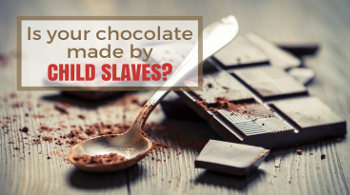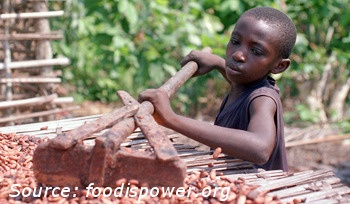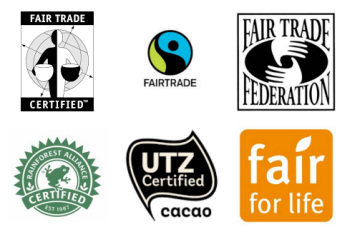 “Every time you eat their chocolate you are benefitting from child slavery,” said Patti Rundall, policy director at campaign group at International Baby Food Action Network quoted in yesterday’s Independent article. “There is very little cocoa production that isn’t sourced in a bad way and it will take a long time to change that due to the nature of large corporations.”
“Every time you eat their chocolate you are benefitting from child slavery,” said Patti Rundall, policy director at campaign group at International Baby Food Action Network quoted in yesterday’s Independent article. “There is very little cocoa production that isn’t sourced in a bad way and it will take a long time to change that due to the nature of large corporations.”
Though perhaps heavy-handed, her statement has some merit. It comes shortly after the U.S. Supreme Court’s decision to reject dismissal of a lawsuit against three major food companies Monday. Nestlé, Archer-Daniels-Midland and Cargill are being sued following allegations that the companies have been importing chocolate made by child slaves in Ivory Coast.
"Factory resistance is common when in a newly established relationship."The three plaintiffs, who brought their case against the companies in 2005, claim they were trafficked from their home in Mali and forced to harvest cocoa beans as children without pay.How did this happen? How prevalent is child slave labor in the chocolate industry? How has Nestlé, the world’s largest food company by revenue, found itself amid yet another sourcing and social compliance scandal? And how can you know if you’re importing or consuming chocolate made by child slaves?
Just how bad is the child slavery problem in the chocolate industry?
While a certain film from your childhood might have you believing that chocolate is made by cheerful, orange dwarfs, real chocolate production is no laughing matter.
According to a 2012 marketing report by the World Cocoa Foundation, West African countries supply 70 percent of the world’s cocoa. Ghana and Ivory Coast are two of the countries that contribute most to this supply. Oxfam reported that cocoa farmers in Ivory Coast earn less than $2 a day on average and many will resort to hiring child labor to keep their prices competitive.
"Cocoa farmers in Ivory Coast earn less than $2 a day."Working conditions of child laborers in Ivory Coast cocoa farms
Most child workers harvesting cocoa in Ivory Coast are just 12 to 16 years old. Reporters and former workers report conditions endured by child laborers including:
- Workdays up to 14 hours long

- The use of machetes to cut pods from cocoa trees (in violation of international law)
- Spraying pods with toxic industrial chemicals without the use of protective clothing
- No access to clean water or sanitary bathrooms
- Cheap meals of bananas and corn paste
- Confinement to locked rooms to prevent escape, and
- Severe beatings and whippings for those that work too slowly or attempt escape
It’s also been reported that guards will slice open the feet of any child that tries to escape.
"West African countries supply 70 percent of the world’s cocoa."The lawsuit against Nestlé and others for labor rights violations
The current allegations against Nestlé of supplying chocolate made by child slaves may be shocking to some. But they may be less shocking to those aware that this isn’t the first time the company has been accused of involvement in unethical practices.
The lawsuit against Nestlé comes just two months after the company announced–in their own report–findings of slave labor in their seafood supply chain in Thailand. And forty years ago, allegations surfaced over Nestlé’s heavy marketing of baby formula, a less healthy and more expensive alternative to breast milk, to mothers in the third world.
Buildup to the lawsuit and investigation
Nestlé signed the Harkin-Engel protocol in 2001, a voluntary agreement by major players in the cocoa industry to work toward ending child labor.
Just four years later, the case alleging the use of forced child labor was brought to court against Nestlé, Archer-Daniels-Midland and Cargill.
 While the case stalled in appeals court, a bill was introduced to U.S. Congress that would have forced distributors of cocoa products to add labels guaranteeing that no child labor was used in production. In 2010, Nestlé successfully blocked that bill from becoming law.
While the case stalled in appeals court, a bill was introduced to U.S. Congress that would have forced distributors of cocoa products to add labels guaranteeing that no child labor was used in production. In 2010, Nestlé successfully blocked that bill from becoming law.
A 2014 report by the Fair Labor Association (FLA) visited 260 cocoa farms used by Nestlé in Ivory Coast. A report found 56 workers employed under 18 years of age, of which 27 were under 15 years.
Now, some ten years after the initial lawsuit, the Supreme Court has rejected Nestlé’s request to have the case thrown out. The plaintiffs in the child labor lawsuit have cited the Alien Tort Statute (ATS) in their case. They’re claiming workers’ rights abuses that would violate the Alien Tort Claims Act, Torture Victim Protection Act, U.S. Constitution and California state law.
Response and implications of the lawsuit
Activists and campaign groups like the International Baby Food Action Network may be celebrating the Supreme Court’s decision not to block the case. But several business groups in the U.S. and Europe, including the U.S. Chamber of Commerce have come out against the lawsuit. They claim that ending human child slavery would threaten “corporate human rights”.
In their Amicus Brief to the Supreme Court, representatives from these groups wrote: "Some judges might genuinely desire that U.S. companies stop doing business with cocoa farmers in Côte d’Ivoire… however, [the decision] is not the judiciary’s to make, and the ATS certainly is not a tool that private parties may wield to dictate foreign policy."
It’s important to recognize that exercising legal jurisdiction in the U.S. over matters abroad has been the subject of controversy. Still, foreign citizens have been successful in using the Alien Tort Statute to win civil cases concerning human-rights violations outside the U.S.
But as the statute applies specifically to tort law, it cannot be used to prosecute violators criminally. And even if the plaintiffs win their case, the profits gained by companies that use unpaid or child labor may exceed whatever amount they end up paying in restitution to their victims.
Are you importing or consuming chocolate made by child slaves?
At this point, you may be wondering if you yourself might have unwittingly had a hand in supporting forced or child labor. The good news is there are some measures you can take to make sure you’re owning consuming or importing chocolate from ethical sources.
Consumers and slave-free chocolate
How can you find out if the chocolate you’re eating is the product of slave or child labor? Organic and Fair Trade chocolate almost always comes from ethical  sources. And cocoa beans that aren’t grown in West Africa are typically a safe bet.
sources. And cocoa beans that aren’t grown in West Africa are typically a safe bet.
There are a number of stamps typically found on products that contain chocolate to indicate they are “fair trade certified” or ethically sourced. You can also check a list of verified slave free chocolate suppliers to learn more.
Importers and slave-free chocolate
As an importer, investigating your supply chain can be difficult, especially if your suppliers are layered with contractors and subcontractors. Nevertheless, you have a responsibility to your retailers, and your reputation as a brand depends on it. Your retailer may refuse to continue distributing your products if they uncover labor rights violations during a formal audit. And the California Transparency in Supply Chains Act specifically addresses human trafficking and forced labor.
The best advice is typically to audit your suppliers by means of a social compliance audit. Social compliance audits are often based on the internationally recognized SA8000 standard. They can also be based on the standard of specific brands or retailers, such as Apple or Walmart, though these generally share the same or similar requirements.
If an audit of your suppliers turns up serious violations, develop a Corrective Action Plan (CAP) with the supplier to address issues. If you don’t see significant changes or cooperation from a supplier, it’s recommended that you look for a new supplier that is able and willing meet your standards. You can see some of the corrective actions Nestlé proposed in 2013 and the follow-up findings in the 2014 FLA report.
Conclusion
Businesses have always tried to cut costs in a competitive market, some employing unethical measures in the process. In the case of cocoa harvesters in Ivory Coast, rising demand for a commodity and high competition forced farmers to take drastic measures to stay afloat. So what we got, hungry consumers and importers alike, was chocolate made by child slaves.
And although we don’t yet know what will be the outcome of the case against the major food giants, we do know forced labor continues to be a problem that draws international attention. Stories of labor violations have led to protests, brand boycotts and class action lawsuits.
For now, I’ll leave you with the poignant words of one former slave of the chocolate trade who said, “When people eat chocolate, they are eating my flesh.”
"“When people eat chocolate, they are eating my flesh.”"Give a listen to John talk about this topic further in the manufacturing podcast.







